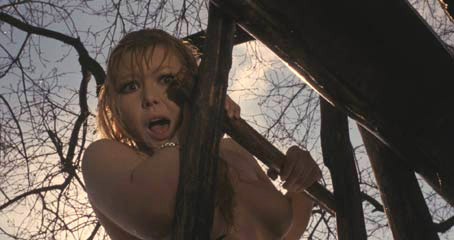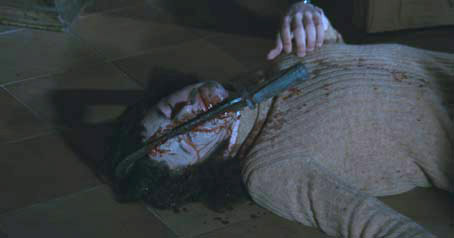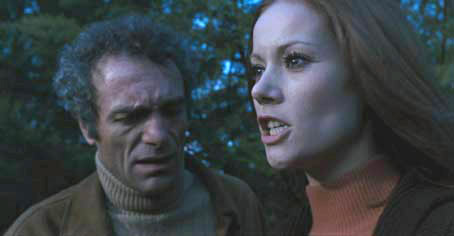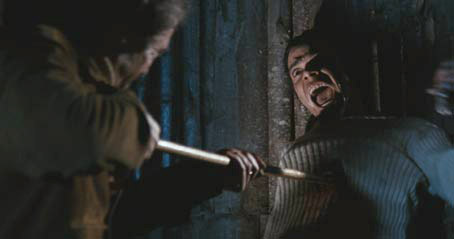|
See if any of this has a familiar ring. In an isolated bayside house, Count Filippo Donati murders his wife Federica and makes the death look like suicide, only to be then stabbed to death by an unknown assailant, who drags his body off to hide all trace of this second crime. A while later a group of four fun-seeking youngsters stumble on the now empty property and decide it would be a great place to party, unaware that they are being secretly observed. Over the course of the next few hours they are all violently killed by an unidentified assailant.
Standard 80s slasher fare, then. Well, not quite. First up, we've not even reached the halfway point by the time those pesky kids have been slaughtered. Secondly, the film was made back in 1971, almost ten years before the slasher cycle really kicked off. Thirdly, by this point we've already been introduced to a number of other characters whose role in the unfolding drama has yet to be revealed. And they're a curious bunch. There's estate agent Frank Ventura, who's boffing his secretary Laura and has his eye on the Countess's house with a view to turning the area into a resort. And there's entomologist Paolo Foscari, who believes the countess was murdered and whose wife Anna's boozing helps quell her concerns about sinister signs she reads in the tarot cards. Then there's handyman Simon, who catches squid for a living and is convinced that the countess died by her own hand. And what's with that couple in the bushes further up who spy on the others with binoculars?

That last pair, it turns out, are Filippo's daughter Renata and her husband Albert, who are looking for clues to what happened to their dad, who unknown to them is at the bottom of the bay. An argumentative pair who happily abandon their two young children for the evening, they drop in on Paolo and the wine-gobbling Anna and learn that Simon is actually the Countess's illegitimate son. "There's only one obstacle between us and that inheritance," Renata says a little too loudly as she and her hubby trot off to meet her new brother. Simon claims to know nothing about the disappearance of Filippo. So how come the man's head is sitting in his boat being French-kissed by a squid? Simon says he inadvertently caught it while fishing, but he doesn't seem remotely rattled by his grisly find. Is Simon the killer? Are any of them the killer? Hard to be sure, but there's enough suspicious behaviour and motivational moral bankruptcy to make just about anyone a suspect at one point or another. I'm being serious here. As the bodies pile up it becomes less about who might be guilty than who might not be. Just about everyone in the film appears capable of murder and those who commit it do so with troubling ease. Greed proves to be a deadly motivator, though whether this was intended by the filmmakers as social commentary or was merely a handy narrative catalyst I wouldn't like to say, but I salute what it says about those who worship at the materialist altar.
A Bay of Blood [Reazione a caten], aka Twitch of the Death Nerve (an even better title, frankly, and one of many alternatives), was the work of Italian horror maestro Mario Bava, whose 1960 The Mask of Satan [La maschera del demonio] remains one of the most admired and influential genre works of the second half of the twentieth century. And yet Bay of Blood's fame, at least in the UK, stems primarily from its inclusion on the Department of Public Prosecution's 1984 hit list. Yes, A Bay of Blood was a fully fledged video nasty and was consequently banned from home video distribution on these troubled shores. The offending scenes aren't difficult to spot and include the hanging of a handicapped woman, a graphic (though brilliantly edited) throat cutting, an even more graphic beheading, and a Freudian humdinger in which a copulating couple are simultaneously killed by a spear thrust through their bodies and into the mattress below (a scene lifted wholesale by Friday the 13th, Part 2). There's a suspicion, however, that what really upset the British censor was the image of a still wriggling insect pinned to a board, something Bava himself is said of have regretted including. Well he would, wouldn't he.

The budget may have been low – two of the house interiors apparently belonged to director Bava and producer Giuseppe Zaccarielli – and the English dialogue shaky, but this is still a classily made thriller that is more 70s giallo than 80s slasher. Former cinematographer Bava is his own cameraman here and serves his director well, particularly in the moody location work, POV handheld shots, offbeat angles and eye-catching close-ups. Carlo Reali's editing, meanwhile, is sharp enough to convince you that you clearly saw that cleaver plunged into young Roberto's face, when frame-by-frame examination reveals that you saw nothing of the sort. For a low-budget film, the makeup effects are pretty damned good, the work of one Carlo Rambaldi, who went on to create effects for the likes of Flesh for Frankenstein, Deep Red, Close Encounters of the Third Kind and Alien. He was also responsible for creating the title creature in E.T., but we'll let that one slide. And effective though Stelvio Cipriani's score may be, it's Bava's use of silence that really hits home, building real atmosphere and tension in sequences that lesser filmmakers would castrate with musical overstatement.
What was once dismissed as a video nasty is now widely acknowledged as one of the most important and influential works of 70s horror cinema. It's opening half-hour is practically a template for the 80s slasher cycle, precious few of which came close to matching the mood and gory inventiveness served up by the Bava-Rambaldi team. Inventive, ambitiously plotted, intermittently surprising and a good deal of dark fun, it's a testament to Bava's skill that he makes Countess Federica's melancholic wheelchair-bound wander through her house (and, we suspect, her memories and disappointments) every bit as compelling as the naked Brunhilda's creepy encounter with a waterlogged corpse. And unlike most of the films it inspired, it's got an absolute belter of an ending.
Oh how times change. I'm sure I'm not the only one whose first viewing of A Bay of Blood was on badly worn VHS with the picture cropped to 4:3. And now here it is, restored and remastered in high definition. And yes, the rock solid, whistle-clean picture and increased level of detail are a genuine revelation, and while the colours are sometimes a little muted (see the Tim Lucas commentary below), there's no sign of over-saturation when they do shine through. It's not all good news, as while the brighter scenes have a well -balanced contrast range, black levels are weak in much of the night footage. This does preserve some detail that might otherwise have been lost and gives some of the woodland exteriors an almost otherworldly feel, but there is a sense that the transfer sometimes leans a tad too far in this direction and that a little more punch could still have been achieved (check the clips in the extras for comparison, which have been taken from a different source). At its best – daytime exteriors and well-lit interiors once again rule the roost – the results pour scorn on the film's past video nasty status and nicely showcase Bava's own cinematographic skills. But be warned, there are a lot of those darker scenes.

The Linear PCM 2.0 surround soundtrack is actually the mono original spread across the front sound stage. Free of damage and reasonably clear, the dynamic range is a little restricted and there is some audible background fluff in quieter scenes, but the results are still superior to previous versions and the one on the Italian language version detailed below.
Italian language version
Although it sounds like a redub at times, it's clear from the matching of words to mouths that A Bay of Blood was actually shot in English, or at least the version with the 1080p transfer is. Rather than redub the film for an Italian or English speaking audience, Bava apparently shot all of the dialogue scenes in both languages, and the Italian print is thus technically a different version. The differences in performance are immediately evident, with a more naturalistic delivery from an Italian cast who are clearly more comfortable with their mother tongue. The dialogue also differs from its English language equivalent, at times to surprising degree, giving a different take on some of the character interplay.
Although reasonably clean, the print quality on this version is otherwise some way short of the main feature, with fuzzier detail and seriously burnt out whites – when Filippo places the suicide note next to his murdered wife, the lettering is lost is a ball of high contrast light. The black levels are far better than those on the main feature, but at the expense of detail in darker areas – the ideal probably lies somewhere between the two. The soundtrack also has a little less finesse than the English track. There are, it should be noted, no chapter stops in this version, but the English subtitles are optional for those of you fluent in Italian.
Tim Lucas audio commentary
The author of Mario Bava: All the Colours of the Dark delivers an informative if dryly spoken expert commentary that provides plenty of information on the cast, the locations, how the film came about and, of course, the director. There are quite a few dead spots, but they don't usually last more than a minute or two. It's worth noting that elsewhere Lucas is quoted as saying that the colours on this transfer "appear to be too muted" and that "it's not quite accurate to nature and certainly not accurate to Bava." I'm not in a position to agree or disagree on this one, but the man knows his Bava.
The Giallo Gems of Dardano Sacchetti (33:09)
A Bay of Blood screenplay (co-) writer Dardano Sacchetti talks about his work with three legends of giallo cinema – Dario Argento, Mario Bava and Lucio Fulci – and his working relationship with Italian movie mogul Dino de Laurentiis. Plenty of interesting stories here, notably in the different working methods of the directors – according to Sacchetti, Argento was a rock star who liked being in charge, Bava was a genius who allowed you freedom, but Fulci was the professional.
Technically the piece is not all it should be, with sound mix exhibiting a number of very audible distortion blips, while clips from trailers play at half the volume of the interview, which for no obvious reason emanates from the rear speakers rather than the front. The included clips vary wildly in quality, with the trailer for The Psychic looking like it's been hauled off of YouTube and the Bay of Blood extracts stuttering like a bad NTSC standards conversion. And does an interview really deserve its own title sequence and end credits? The best-looking clips are from Argento's Cat O' Nine Tails, which is due for a Blu-ray release from Arrow (bless 'em) in April, suggesting this interview may have originally have been produced with that release in mind. If the quality of the clips here are anything to go by, that's going to be a mouth-wateringly good transfer.

Joe Dante remembers Twitch of the Death Nerve (12:24)
Another unnecessary, overlong, but at least decently executed title sequence delays access to an engaging appreciation of Bava's work (and A Bay of Blood in particular) by director Joe Dante, who once claimed that the film had the best ending since Citizen Kane. The clips vary in quality but the poster artwork looks great. Dante sounds as if he was interviewed in in an acoustically unfriendly storeroom without a clip mic.
Shooting a Spaghetti Splatter Classic (21:16)
Another title sequence with treated film extracts and that yellow Copperplate font precedes an interview with Bava's assistant cameraman on A Bay of Blood, Gianlorenzo Battaglia, who talks about working with Bava as both assistant and cinematographer, with appropriate focus on A Bay of Blood. The picture is awash with digital grain and looks like it was shot on DV in low light.
Carnage Trailer with Edgar Wright (3:56)
Borrowed from a series called Trailers From Hell, director Wright talks us through the trailer for the film under one of its alternative titles, explaining why he loves the movie and singing a hymn to the ending.
Twitch of the Death Nerve Trailer with Edgar Wright (1:17)
Another from the Trailers From Hell series covering what Wright believes was the film's best ever title. He also gives a shout for its unused working title That Will Teach Them to Be Bad.
There are also two brilliant Radio Spots (1:00 & 0:28) that suggest watching this film will be the most traumatic experience of your life.
The release disc also has a reversible sleeve with original and newly commissioned art work, double-sided fold-out poster, and a collector's booklet by Jay Slater, critic and author of Eaten Alive!. These weren't included with the review disc.
Arrow are starting to carve a serious reputation as the masters of UK Blu-ray horror with their feature-rich and impressively packed high-def releases of past genre favourites, and while not one of their very best, this revival of one of Mario Bava's most influential films continues that trend. The sometimes soft colours and weak contrast in the darker scenes is definitely disappointing, but it's hard to say how much of this was down to the condition of the source material and there's nothing on the disc itself to confirm this one way or another. Technical issues aside, the extras are all interesting, and seeing a former video nasty get an uncut Blu-ray release gives me a satisfying sense of up-yours to those who once successfully campaigned to have it banned. For the horror faithful at least, recommended.
|